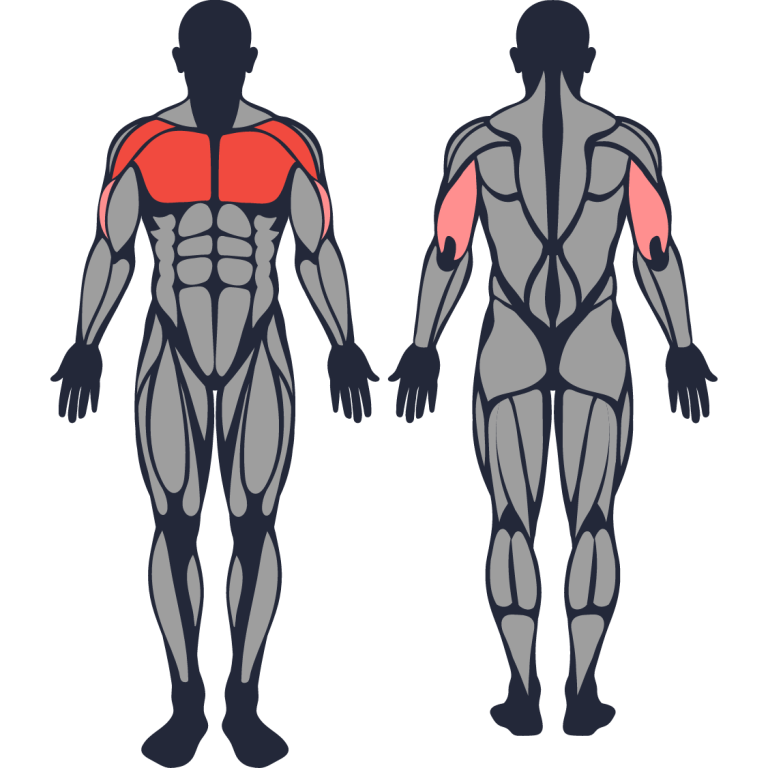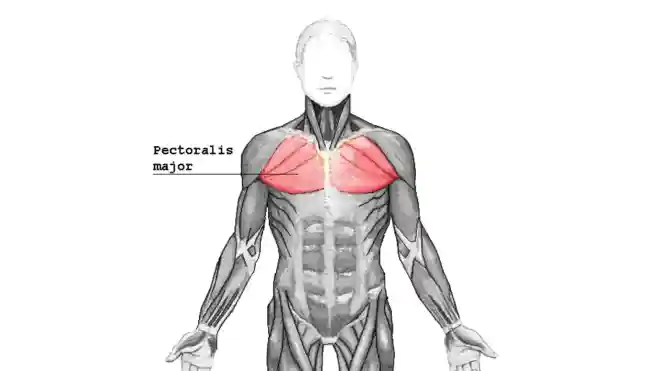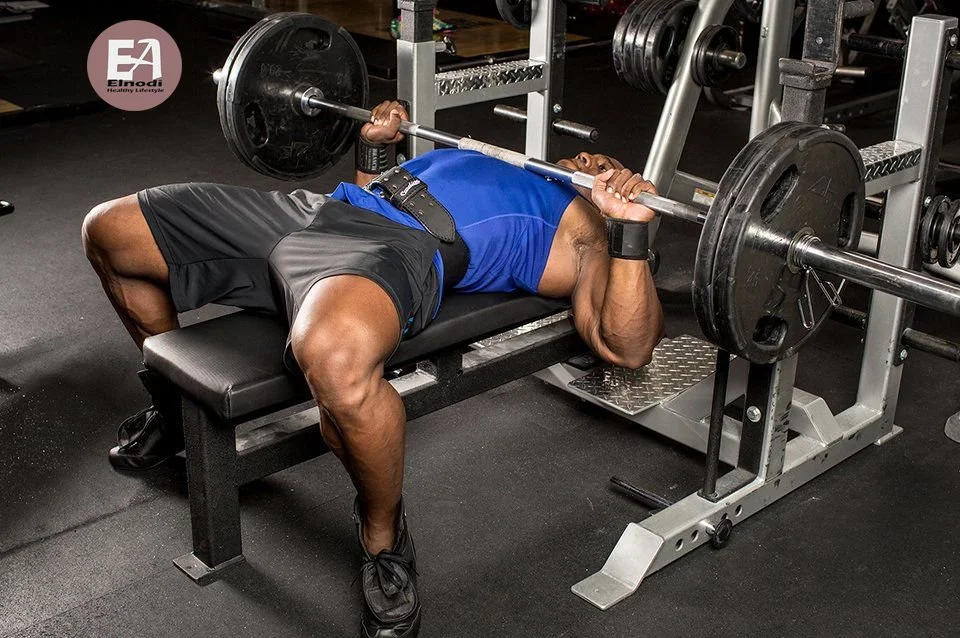If you want to see results with your chest workout, incorporating some of these awesome barbell chest exercises will help you achieve them!
If you want to develop thickness, muscle, and strength in your pecs, here are the finest barbell chest exercises and workouts to include in your chest training routine. A well-developed chest adds to the fullness of the upper body and provides functional advantages.
To effectively train the chest, we will first examine the chest anatomy, followed by the execution method and the greatest barbell chest exercises and pro-tips.
What Are Barbell Chest Exercises?

Weight-training activities in which participants hoist big weights loaded onto a barbell are known as barbell chest workouts. Weight plates deliver the weight, allowing you to gradually increase your ability to lift greater weights.
Even if you opt to perform barbell workouts at home, most gyms include all of the equipment you need to begin incorporating barbell chest exercises into your workout program.
Benefit Of Barbell Chest Exercises

There are numerous reasons why you should do barbell chest workouts, and I’ve included a few of them here.
Barbells are an important tool in the armory of anyone looking to increase strength quickly. Barbells have various other advantages, according to exercise experts.
- Barbell chest exercises work the upper body muscles, such as the pecs, arms, and shoulders.
- barbell chest exercises are versatile in that they may help you build practically every muscle in your body with a broader range of resistance.
- Because the barbell is such a simple instrument, learning the fundamental lifts is simple.
- When done correctly, barbell chest exercises can assist build strength in your stabilizer muscle groups, allowing you to stand tall and keep your back straight.
- Other advantages of using a barbell chest workout in your weight-training routine include increased upper body strength and muscular endurance.
Barbell Chest Exercises

1. BARBELL FLAT BENCH PRESS
The bench press is a basic workout that should be a part of your program if you want to increase your chest size and strength. The bench press works the muscles in your chest, triceps, and shoulders, thus it will help you build a muscular torso.
When compared to other chest workouts, the bench press can be loaded with a relatively substantial amount of weight. Lay back on a bench, slightly arch your lower back, and lay your feet on the floor.
Pull your shoulder blades together to improve your upper back strength and stability. Squeeze the hand firmly to flex the arm and grip muscles as much as possible while holding the bar (with any number of different grips). Consider pulling the barbell to the body to touch the sternum/base of the chest while the load is unracked. Raise the weight to your shoulders. Maintain a stiff back and draw your shoulder blades together.
2. INCLINE BENCH PRESS
When pressing a barbell (or a set of kettlebells or dumbbells) from an inclination, more muscle fibers in the upper chest are used, as are the shoulder muscles. As a result, many weightlifters prefer this form of chest press variation because it has greater carryover to workouts such as leg presses and axle bar clean and presses.
Some advantages of the barbell incline bench press include increased shoulder and upper chest activation, especially when compared to other flat press versions. Because it strengthens the deltoids, the incline bench press will transfer over to overhead pressing variations.
Adjust a workout bench to a 45-degree angle and set it up with a shoulder-width grip as you would use for a standard flat bench press. Unrack the loaded barbell and begin to pull the load downwards to line with the upper chest (a few inches below your clavicle). With the shoulder blades pulled together and your elbows angled at about 45 degrees, go ahead and push the barbell upward.
3. DECLINE BENCH PRESS
The pectoralis major is a chest muscle that is thick, fan-shaped, or triangular in shape. Because it is the largest and most superficial muscle in the chest, the pectoral major is sometimes known as “pecs,” “pectoral muscle,” or simply “chest muscle.” The third major barbell bench press variation, the barbell decline bench press, targets your pectoral fibers in the lower chest.
This pressing variation is sometimes considered a little less strenuous on the lifter’s shoulders than the standard bench press because of the slightly shifted shoulder angle.
Some advantages of the barbell decline bench press include less strain on your shoulder joints as a result of the angle of the bench employed for this exercise. There is also a larger emphasis on the lower pectoral fibers, which can lead to increased strength and quick muscular building.
attaching your feet to a decline bench set up and attaching your upper back and hips to the bench (like you would in a flat bench press) should be your beginning posture. Unrack the weight and draw it down toward the sternum in a close-grip motion, keeping the shoulder blades pushed together.
Press through the barbell to lock your elbows. Be sure not to allow your elbows to flare out at all when completing this movement.
4. Barbell Pullover
Why not attempt a barbell pullover exercise if you want to get more creative with your barbell chest workout?
Barbell Pullover is the ideal exercise for developing a strong rib cage and the serratus anterior muscle in order to develop a full chest and back. To develop the back, pullovers operate directly on the serratus anterior muscle.
how to do a barbell pullover:
- Lie across on a bench on your shoulders so that your head is hanging.
- Using an overhand grip that is somewhat broader than shoulder-width apart, grasp a barbell.
- Raise the barbell till it is over your chest.
- Lower the barbell behind your head slowly while maintaining your elbows slightly bent.
- Reduce the weight till it hits your stomach or chest.
- After a brief pause, steadily raise the barbell back to its starting position.
5. Incline Reverse Grip Bench Press
An Incline bench barbell press with a reverse grip focuses the most on the upper pecs. Begin slowly and make sure your thumbs are looped around the bar for safety.
The reverse-grip bench press may not appear to be an upper chest workout, but it is, as explained in this exercise anatomy.
An Incline bench barbell press with a reverse grip focuses on the upper pecs the most. Begin lightly and keep your thumbs looped around the bar for protection.
The reverse-grip bench press may not seem like an upper chest move, but it is absolutely an upper pec exercise as explained in this exercise anatomy.
how to do an incline reverse grip bench press:
- Place your feet level on the floor and your knees bent on an incline bench.
- Using a reverse grip that is somewhat broader than shoulder-width apart, grab a barbell.
- Lower the barbell to your chest while maintaining your elbows slightly bent.
- Squeeze your chest as you press the barbell back up to the beginning position.
6. Reverse Grip Press
This simple and extremely efficient shoulder-friendly pressing variation aids in the development of triceps bulk and strength.
The floor press concentrates on the triceps’ active range at the end of the chest press (bench press). It is usually done to promote lockout strength and tricep development.
how to do a reverse grip press:
- Place your feet level on the floor and your knees bent on a flat bench.
- Using a reverse grip that is somewhat broader than shoulder-width apart, grab a barbell.
- Lower the barbell to your chest while maintaining your elbows slightly bent.
- Squeeze your triceps as you press the barbell back up to the beginning position.
7. Close-Grip Bench Press
The close grip bench press is a form of bench press that is designed to improve triceps muscle and strength. This position focuses on increasing the strength and growth of the triceps muscles as well as the chest.
When it comes to exercises that will pack mass onto your triceps, the close grip bench press is unrivaled. This exercise is another excellent choice for targeting the chest and triceps and building upper body strength.
how to do a close-grip bench press:
- Place your feet level on the floor and your knees bent on a flat bench.
- Using a close grip that is a little narrower than shoulder-width apart, grasp a barbell.
- Lower the barbell to your chest while maintaining your elbows slightly bent.
- Squeeze your triceps as you press the barbell back up to the beginning position.
8. The Landmine Chest Press
Why not try the landmine barbell chest press exercise if you want to get more creative with your inner chest workout?
The Landmine Press is not a well-known workout, but it has numerous advantages for developing your inner and upper chest.
It can be done in a kneeling position, which enhances core engagement and helps improve core stability and abdominal muscular strength. It is one of the best inside chest exercises; include it in your chest workout routine.
how to do a landmine chest press:
- Connect a landmine connection to a barbell.
- Kneel with your feet shoulder-width apart on the floor.
- Using an overhand grip that is somewhat broader than shoulder-width apart, grasp the barbell.
- Maintain a straight back and an engaged core.
- Keep your elbows slightly bent as you lower the barbell to your chest.
- Squeeze your chest as you press the barbell back up to the beginning position.
Summary
If you want to completely train the muscle group, you’ll need to try a variety of other workouts with a variety of equipment and techniques. Variety is one of the most important factors in muscular adaptation, so challenging your chest in new ways will be a crucial driver of growth.
Working the chest muscles can only improve your quality of life, whether your aim is a sculpted chest or a stronger upper body. The barbell chest exercises described above, combined with a high-protein diet, may help enhance the size and strength of these muscles.





